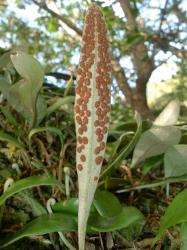- = Cyclophorus Desv., Mag. Neuesten Entdeck. Gesammten Naturk. Ges. Naturf. Freunde Berlin 5: 300, t. 7, fig. 4 (1811)
- = Niphobolus Kaulf., Enum. Filic. 124 (1824) nom. illeg.
Epiphytic or rupestral ferns. Rhizomes long-creeping (NZ) or short-creeping (not NZ), terete, lacking cavities, not pruinose, densely scaly. Rhizome scales non-clathrate, squarrose or appressed. Fronds monomorphic or dimorphic, articulated to short stalks (phyllopodia) at intervals along the rhizome. Laminae undivided, thick, coriaceous to succulent, covered with stellate hairs. Veins obscure, hydathodes present or absent. Sori round or slightly elongate, superficial or partly impressed into the lamina, arranged in one to many rows either side of midrib, sometimes confluent with age, often confined to distal part of lamina, paraphyses present as stellate hairs, exindusiate. Spores monolete, bilaterally symmetrical, verrucate to tuberculate.
A genus of over 50 species (PPG 1 2016).
Pyrrosia was revised by Hovenkamp (1986) and his treatment is followed here. Previously, Allan (1961) had referred the only known New Zealand species to P. serpens, but Hovenkamp (1986) recognised it as the endemic species P. elaeagnifolia. Traditionally only one species of Pyrrosia has been recorded in New Zealand, but Brownsey et al. (2021) reported a collection of P. serpens from Dayrell Island in the Kermadec Islands, extending the known distribution of that species from the tropical Pacific into the subtropical zone.
Recent taxonomic studies have subdivided Pyrrosia into four or six subgenera (Vasques et al. 2017, Zhou & Zhang 2017). In both of these approaches, the New Zealand species belong to subg. Niphobolus. However, within this subgenus, phylogenetic analyses of chloroplast DNA sequences have demonstrated that more investigation is needed to clarify the circumscriptions and relationships of several species, as summarised by Brownsey et al. (2021).
Species of Pyrrosia are easily distinguished from other members of the family by their thick, fleshy, undivided fronds, dense covering of fawn-coloured stellate hairs, and exindusiate sori arranged in one to several rows either side of the midrib. Paraphyses are present as stellate hairs (Baayen & Hennipman 1987, pl. 9). Spores are verrucate to tuberculate (Van Uffelen & Hennipman 1985, pl. IX; Large & Braggins 1991).
Pyrrosia is largely confined to the palaeotropics, extending to the south temperate zone in southern Africa, eastern Australia and New Zealand, and to southern China and Japan in the north temperate zone. It reaches its greatest diversity in the Himalayas and south-east Asia (Hovenkamp 1986). Three species in Africa, four in Australia, six in the Pacific, and the majority in Asia from India and China to Malesia and New Guinea (Hovenkamp 1986). Two species indigenous to New Zealand.
| Category | Number |
|---|---|
| Indigenous (Endemic) | 1 |
| Indigenous (Non-endemic) | 1 |
| Total | 2 |
n = 36, 37, 74, 108–111 (Hovenkamp 1986).




